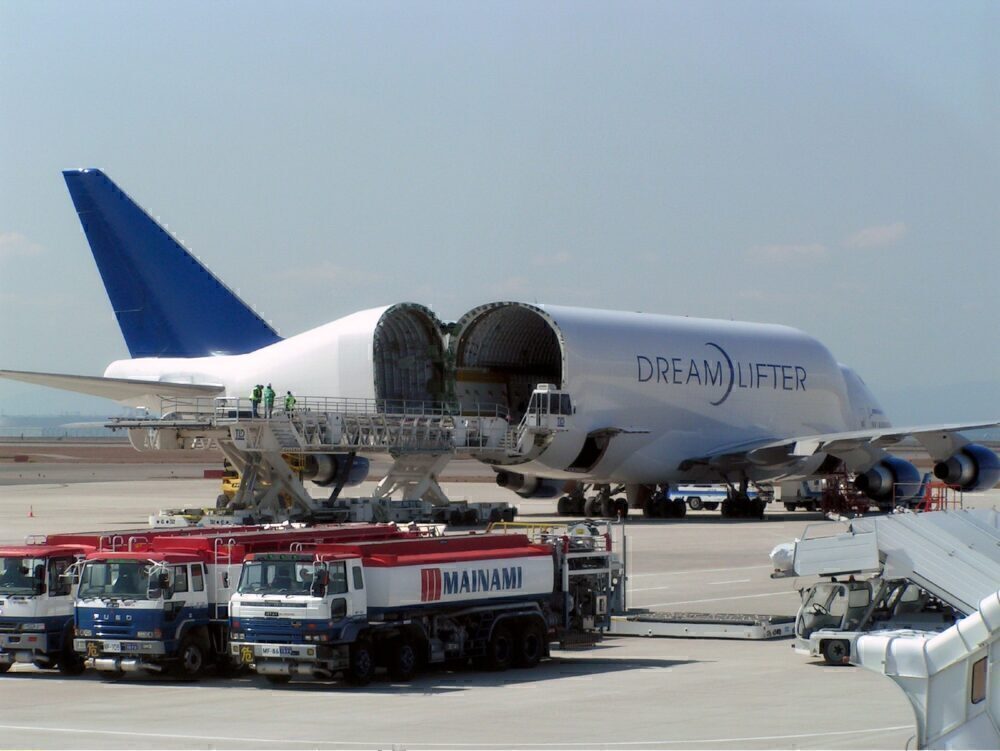Particularly since the onset of the coronavirus pandemic, airfreight has played a significant role in keeping the world moving. Several passenger airliners have specialized cargo-carrying variants, onto which cargo is loaded conventionally through its main doors and belly cargo holds. However, this is not the case for Airbus’s outside ‘Beluga’ family of cargo aircraft. Let’s take a look at how its loading procedures differ from regular freighters.

What is the Airbus Beluga?
Airbus developed its legendary ‘Beluga’ outsize cargo aircraft from its existing A300 design. This aircraft had been the company’s first airliner, as well as the world’s first twin-engine widebody design. It entered service with Air France in May 1974.
By the 1990s, with Airbus having experienced strong growth in the intervening 15-20 years, the need had arisen for the company to develop an outsize freighter. Having initially transported components by road, it later flew them between its various European facilities, such as Hamburg, Germany and Toulouse France, using turboprop-powered Super Guppy aircraft. However, it was planning to with these in the mid-1990s.
Stay informed: Sign up for our daily and weekly aviation news digests.

As such, Airbus produced five A300-600ST (Super Transporter) aircraft between 1992 and 1999 to replace the Super Guppy and modernize its outsize cargo fleet. Owing to their bulbous fuselages, they became affectionately known as the ‘Beluga.’ More recently, Airbus has introduced a next-generation version based on the A330, known as the Beluga XL. But how exactly does the company load its Beluga planes with their outsize cargo?
How is it loaded?
Given the nature of cargo that the Beluga carries, it cannot be loaded in the same way that regular freighters receive their goods in containers. As such, Airbus had to improvise a door that was large enough and could open wide enough for aircraft components to go straight in from the front. As seen above, it had already done this with its previous Super Guppy aircraft. However, this system was not without its problems.

Indeed, the sideways-swinging nature of the Super Guppy’s nose door meant that its cockpit systems had to be disconnected and then reconnected when opening and closing it. As such, Airbus elected to utilize an upward-swinging nose door on its new Beluga. By doing this, it was able to relocate the cockpit to below the main cargo deck.
This meant that it was kept separate from the body of the door, thus eliminating the need to disconnect and reconnect its cockpit systems before and after use. The result of this practical consideration was a 50% reduction in loading times. The Beluga XL has retained this style of door. Once open, cargo is loaded through the enormous, horizontally-hinged door using roll-on/roll-off equipment, as seen above. This also saves time and, with it, money.
A contrasting style to its competitor
Airbus is known for making up the European half of the industry-dominating Airbus-Boeing manufacturing duopoly. Much like Airbus, its American rival also found that it was necessary to produce an outsize freighter to transport larger aircraft parts.

It did so in the form of the Boeing 747 ‘Dreamlifter,’ which entered service in 2007. However, while it serves a similar purpose to the Beluga family, it is loaded differently. Indeed, its cargo enters the aircraft at the rear, thanks to its enormous swinging tail door. Simple Flying took a closer look at this innovation earlier this month.
Unfortunately, the effects of the ongoing coronavirus pandemic have slowed aircraft production. This has left minimal demand for these planes to be ferrying parts between facilities. Nonetheless, the unorthodox loading of the ones that have operated will have made for a spectacular sight!
Did you know about how Airbus loads its ‘Beluga family outsize cargo aircraft? Perhaps you’ve seen it happen in person? Let us know your thoughts and experiences in the comments!
[ad_2]
Source link


